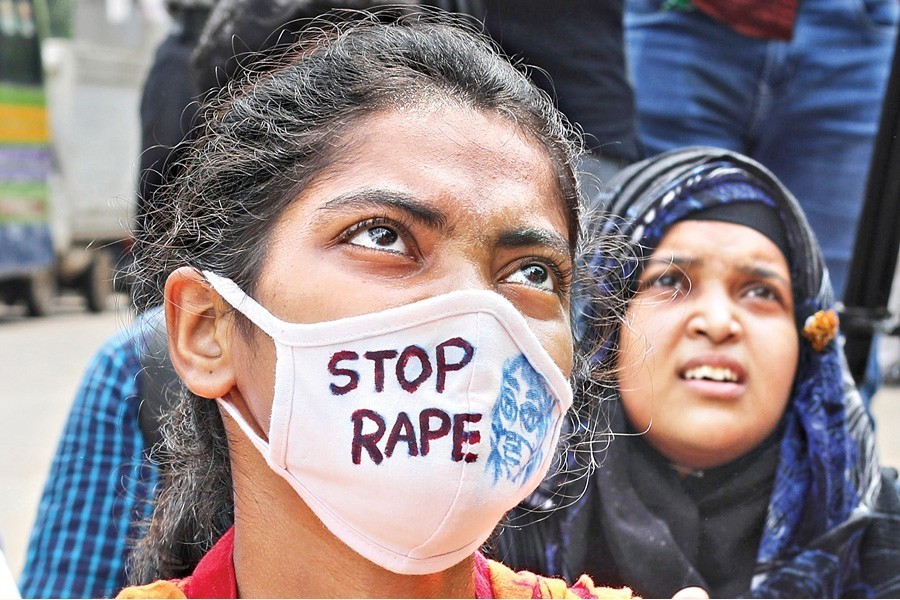The frequency of gang rapes seems to have increased to epidemic proportions in recent weeks in Bangladesh and India. Circumstances of each of such organised sexual attack on women may be different, but certain features of both the victims and their molesters fall into a pattern. For, in most of the reported incidents, the victims are attacked when they are alone and the attackers are in a group. And in addition to the violence of sexual nature, the victims are also subjected to physical assaults including beating, maiming and mutilation of genitals leading to mortal wounds on the victim's person. It indicates a kind of vengeance was being wreaked on the victim. Why is this 'anger' against a lone, helpless woman by a gang of molesters?
Take the case of the attack on a woman at Eklaspur village of Begumganj in Noakhali. The victim said to the police that she was tormented by the felons of the same gang previously and that they have now made good on their threat of posting the act of horror on the social media.
As the perpetrators were learnt to have been the goons of a drug dealer of the locality, they had, perhaps, some scores to settle with her as she or her husband might have failed to respond to their dictates the way they wanted it. What it actually was will become evident once the investigation is complete.
Evidently, the target of the attack here is from an economically vulnerable group while the attackers represent a powerful criminal racket.
In case of the Khagrachhari gang rape of a Chakma girl too, the victim is from a minority , indigenous community and as such weak and helpless. But the attackers were armed brigands belonging to the majority Bangalee community.
In the Sylhet MC College case, the rapists had powerful social and political background in the locality while the victim was non-local and alone when the attackers pounced on her.
Here, however, there is no evidence of any other agenda of the perpetrators other than self-gratification of sexual nature.
Again, in the Indian UP state's Hathras gang-rape case, the perpetrators were powerful upper caste Hindu youths, while the victim was a lower caste dalit teenager.
The way she was savaged and brutalised bore the hallmark of vengeance! Her fault?
It might be that despite her dalit background, she dared study in a college! So, she had to pay for her chutzpah!
In all these and hundreds of other cases of organised sexual violence against women, there is an element of 'anger' noticeable in the psyche of the perpetrators.
The 'anger' may have to do with modern-day woman's increased awareness about her gender rights. And that goes against the patriarchal perception of male dominance in society.
Small wonder that far from being ashamed of their son's conduct and feeling guilty, the offenders' family members and the community at large often try to protect them. Patriarchal or traditional society's core values are still not against male violence of any form against women. Even some members of the police, who in overwhelming numbers are male, seem to have a kind of 'sympathy' for the offending males, not for the victim woman.
Like many other social evils including prejudices and bigotries, the issue of organised sexual violence against women is yet to be looked upon by society as one of public disgrace and to be dealt with as such. That is why elders do not still voluntarily disown male youths committing such outrage against women unless compelled by the law.
Tara Kaushal, a gender rights activist wrote in an online journal,'The Week,' in one of its December 2019 issue, "the core idea…is that one can perpetrate crimes on others only because we do not see them as human, but as different from and less than human."
The attackers in most cases of organised sexual violence consider the victims less than human. Such an outlook is deeply rooted in social psyche and law alone is not enough to address it through punishing the perpetrators.
In the gang rape, torture and killing of an eight-year-old nomadic Kashmiri girl such mindset of the powerful social and political elites became evident. It was an instance of how a toxic mixture of power and politics thriving in a society polarised along the communal line can be so dehumanised as to consider even an eight-year-old child whatever her ethno-religious origin as an enemy who is expendable and can be outraged in that manner.
There is a growing sense of the 'other'. The 'other' is always the weaker segments of society. Activists as well as media workers working to do way with the curse of gender-based violence from society are also facing a new challenge from polarisation of society.
The rise in the frequency of acts of organised sexual attack against women in South Asia has also a lot to do with the gradual decline in democratic institutions, education devoid of values that emphasise morality and humanity and a mass media that glorifies selfish materialistic gains or success as the measure of an individual's worth.
Society, thus, is structurally getting more violent. Unless a strong social resistance against this tide of value erosion is raised, pro-women rights activists alone with their limited agenda cannot be expected to achieve much.
The incidents of organised sexual violence against women look like happening in isolation. But they are not. So, the fight against this social evil needs to be made part of a greater struggle to change society itself.


